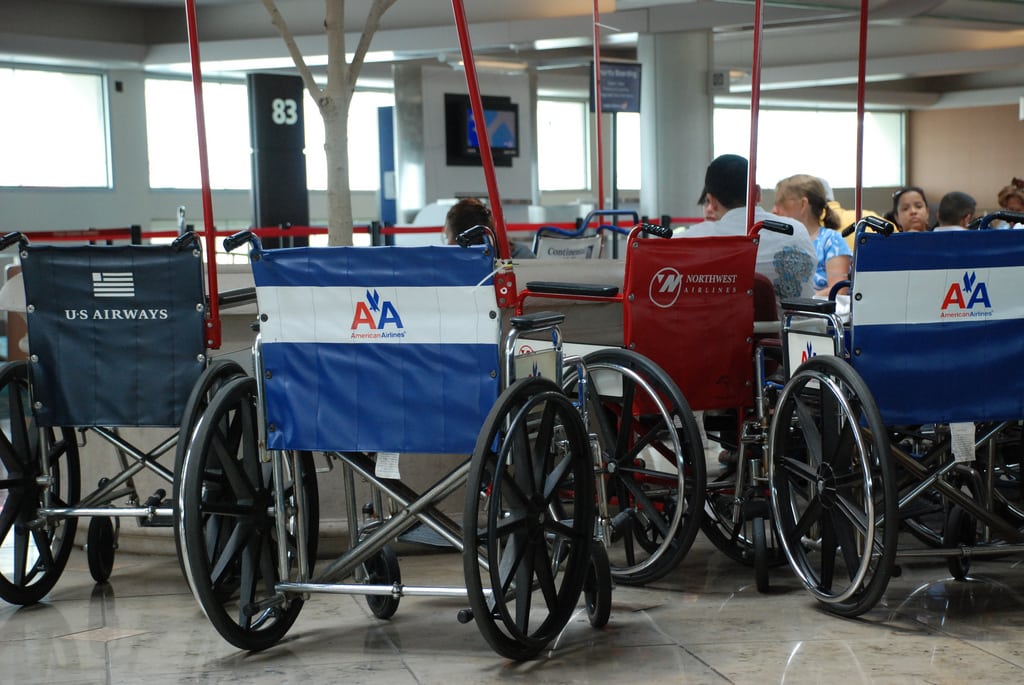Skift Take
Ever-changing equipment poses constant challenges for both travelers and an often undertrained staff at both airports and onboard planes.
Facilitating travel for passengers with limited mobility was a key topic for discussion at the Passenger Terminal Expo (PTE) in Barcelona last week.
Several industry and advocacy groups have banded together in support of key initiatives by passenger rights advocates like Open Doors Organization. We caught up with Laurel Van Horn, Director of Programs and Editor for the Open Doors Organization, and formerly the executive director of SATH (Society for Accessible Travel & Hospitality), after PTE to share with us a bit of the background behind these new regulations; and what additional improvements aviation as a whole needs to make in order to ensure that travel is equality available to all.
“When Eric Lipp founded the non-profit Open Doors Organization in 2000, he was newly disabled,” Laurel tells us. “For the first time, he experienced the barriers that people with disabilities face, even in going out to dine at a restaurant.”
But Lipp channeled his frustration at the inadequate accommodation for persons with limited mobility in a positive direction, by helping businesses do a better job of welcoming and meeting the needs of the disabled. This past week, he spoke at PTE to leading executives and decision makers of the industry on the importance of designing facilities which are accessible to all persons; what has been accomplished and what remains to be done.
As Van Horn explains, there had never been any studies on travel patterns or expenditures of people with disabilities, conducted back in 2000.
“The travel industry understandably did not recognize the importance of the market,” Van Horn says. “In 2002, ODO hired Harris Interactive to conduct the first-ever nationwide study of adult travelers with disabilities in the US. It found that they were spending $13.6 billion annually on travel and that more than 70% of respondents had traveled long distance over a 2-year period.”
Van Horn tells us that the study was repeated in 2005 with similar results, and that ODO is currently conducting a follow-up study with results due out this October.
“In 2009 we began to offer training to Complaint Resolution Officials, the airline disability experts required under the Air Carrier Access Act for all carriers serving the U.S. market,” Van Horn shares. “To date we have conducted training for more than 40 foreign airlines with many more enrolling for our CRO Refresher webinars, an annual requirement for CROs. For airports, ODO offers a Disability Awareness Webinar through Airports Council International.”
ODO launched a certification training program for airline service companies in 2013, and assisted the Transportation Security Administration (TSA) in developing training programs for their Passenger Service Specialists — the TSA’s disability experts.
ODO has also established a training program for ground handlers on the proper lifting and stowing of mobility devices such as manual and power wheelchairs and scooters. “This [training program] is offered free at airports around the US and was also conducted at Heathrow for all carriers prior to the Paralympics.”
ODO has also developed a device to hold wheelchairs on belts for loading and unloading, and help manufacturers of airport products ensure that their equipment meets the requirements of disabled persons, and conducts special Annual and Biennial Conferences to help aviation improve its services and facilities to meet their stated goal: Make air travel universally accessible.
Also present at PTE was the organization Changing Places, started by campaigner Margaret Clough and her daughter Julie, who have pushed for UK airports to improve facilities for partners of disabled persons with adequate changing spaces.
Gatwick airport was the first airport to install these state-of-the-art Changing Places toilet facilities in compliance with BS8300:2009, the British law to ensure accommodation of the needs of disabled persons; equivalent to the US Americans with Disabilities Act of 1990.
Restrooms facilities are also a challenge on aircraft. Current regulations do not require single aisle aircraft to be equipped with facilities which accommodate the needs of disabled persons.
When single aisle aircraft were exclusively dedicated to short-haul flights this was less of a problem, but the range of those aircraft are increasing and Van Horn suggests that design standard needs review. Canada, she points out, requires adequate facilities on single aisle aircraft.
Beyond working on behalf of the rights of persons with limited mobility, the Open Doors Organization is committed to ensuring the needs of all disabled persons and the increasing older population are met. The results of their market studies substantiate that aviation needs to pay closer attention to these passengers.
More than 80% of those surveyed by Open Doors Organization found barriers in airports and airlines. The industry has a lot of room for improvement, and the Open Doors Organization is committed to helping the industry improve.
The Daily Newsletter
Our daily coverage of the global travel industry. Written by editors and analysts from across Skift’s brands.
Have a confidential tip for Skift? Get in touch
Tags: disabled
Photo credit: Wheelchairs at a gate at Orlando International Airport. Peter Dutton / Flickr
